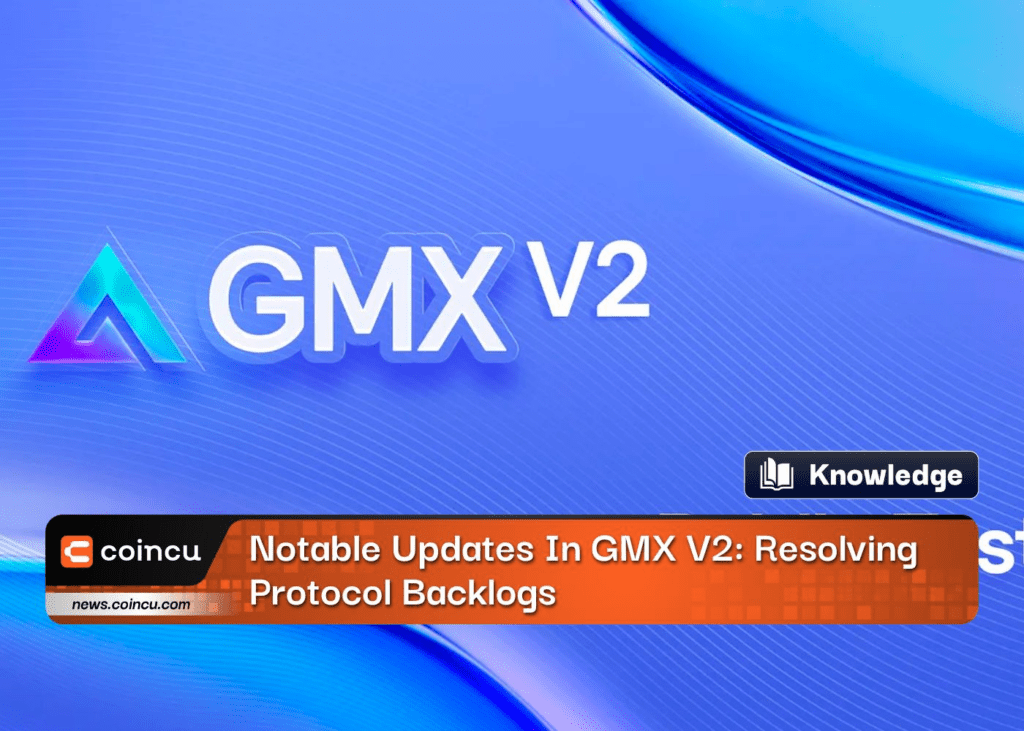Key Points:
- GMX v2 aims to address limitations in its first version, such as high transaction fees, limited asset diversity, and scalability issues for liquidity providers.
- Notable updates in GMX v2 include diversified transaction fees, a novel liquidity provision model with isolated markets, and integration with Chainlink’s oracle solution for improved user experience and order execution.
- GMX v2 holds promise to close the gap with rival DeFi platforms and solidify its position as a leading player in the industry, offering users enhanced efficiency, reliability, and broader asset choices.
Even if the crypto market is in a slump and is receiving a lot of bad news from conventional financial markets, GMX is one of the most effective DeFi technologies. But, GMX’s protocol still has numerous flaws, and the project must evolve if it is to continue to grow. That is how GMX v2 came to be. Coincu will give you with some important information to help you understand how this version works and the major changes.

Big problems with the v1 protocol
GMX is a prominent DeFi platform with a unique “casino game” model, where liquidity providers (LPs) are likened to casino owners and traders to players. The platform faces challenges such as fluctuating Open Interest, leading to potential imbalances and inefficiencies for both LPs and traders.
GMX v1 lacks a funding rate mechanism, putting LPs at a disadvantage and potentially jeopardizing the platform’s stability during adverse market movements.
The GLP token, representing LP liquidity, is vulnerable to extended downtrends due to its close ties to a basket of volatile assets, raising concerns about potential losses for LPs. Various attempts have been made to boost LP profits, including integrating GLP as collateral and introducing Yield Farming protocols, but fully mitigating risks remains a challenge.
GMX faces scrutiny over its comparatively higher transaction fees and limited asset classes, potentially impacting its market share compared to rival DeFi platforms. To ensure long-term resilience and competitiveness, GMX must address capital efficiency issues, improve development team incentives, and refine its operating model, while expanding asset options and optimizing transaction fees.
Notable updates in GMX v2
Transaction fees on GMX are diversified
In a recent proposal adopted by the majority of DAO V2: Interface & Market Parameters, GMX v2 has set its sights on overhauling transaction fees, marking a significant step towards reforming the platform. The upcoming release promises several prominent changes to the GMX market, ushering in a more diverse fee structure.
One of the key changes in GMX v2 revolves around the “Increase / Decrease Position” fee. Under the new system, this fee will range from 0.00% to 0.1%, with an initial value of 0.05%. This alteration aims to make trading more flexible for users while maintaining a fair and efficient system.
Another significant adjustment comes in the form of the “Price Impact” fee. The new system will adjust the fee based on the liquidity available on specific exchanges. This change aims to align transaction costs with market conditions, ensuring a smoother trading experience for GMX users.
GMX v2 also reevaluates the “Swap Fee” structure for both Crypto Assets and Stable Assets. Under the revised framework, the fee will now range from 0.00% to 0.5% for both categories. In its initial form, the fee stood at 0.04% for Crypto Assets and 0.01% for Stable Assets. This modification seeks to strike a balance between the two asset types, encouraging a more inclusive trading environment.
The introduction of the “Funding Fee” adds yet another layer of diversification to GMX v2. This fee is payable by the dominant party to the less dominant party, mirroring prevalent practices on various centralized exchanges (CEX). By embracing this model, GMX aims to enhance fairness and encourage broader participation on the platform.
Moreover, the “Borrow Fee” will now be calculated based on a percentage using the Liquidity Pool and Multiplier Value. This change serves to limit the efforts of traders or competitors attempting to exploit the system through Long and Short orders at minimal cost. Such adjustments are designed to bolster the protocol’s stability and protect users from potential market manipulations.
The “Multiplier Value” in GMX v2 plays a crucial role in adjusting the Funding Fee and Borrow Fee, ensuring a well-balanced and robust ecosystem.
The incorporation of newly introduced fees, including Price Impact, Funding Fee, and Multiplier Value, significantly diversifies the fee market on GMX. A notable distinction between GMX v1 and v2 is the fee structure. While GMX v1 implemented a 0.1% opening/closing fee plus the Borrow Fee, GMX v2 adopts a lower 0.05% order opening/closing fee and includes Borrow Fees, Funding Fees, and Price Impact. This multi-tiered approach aims to provide users with more options and flexibility while transacting on the platform.
Furthermore, GMX v2 incorporates a novel fee-sharing mechanism, unlike its predecessor. Under the new system, transaction fees will be divided among four parties: Oracle, Liquidity Providers (LP), GMX stakers, and the project’s fund, GMX Treasury. This distribution ensures a fairer allocation of fees and rewards the various contributors to the platform’s growth and success.
Innovative mechanism for liquidity
Departing from the traditional approach of sharing liquidity across all trading pairs from a single liquidity pool, GMX v2 has divided the liquidity sources for each trading pair into multiple independent liquidity pools. This new approach empowers liquidity providers (LPs) to freely choose the pools that align with their risk appetite.
Under the GMX v2 model, each perpetual trading pair, such as BTC/USD, will require a mini GLP pool encompassing the respective cryptocurrency and a stablecoin like USDT, USDC, or DAI. Consequently, when traders engage in perpetual contracts involving assets like ETH, the liquidity source will stem from various independent pools containing ETH paired with different stablecoins. This stands in contrast to the v1 model, where liquidity was solely sourced from the GLP pool.
This novel liquidity provision model in GMX v2 bears similarities to popular AMM DEX platforms and Perpetual Protocol systems. By implementing this strategy, GMX can efficiently expand its offerings to numerous assets. Nonetheless, some concerns emerged about the requirement for multiple LPs and various asset types in each pool, potentially limiting scalability.
To address this limitation, GMX v2 has devised an ingenious solution for trading pairs with lower liquidity and riskier tokens. The mini GLP pool for such pairs will consist of the respective cryptocurrency and another stablecoin, mitigating risk and enhancing liquidity.
However, the most pivotal transformation in GMX v2 comes with the introduction of the Isolated Markets model. Unlike its predecessor, which pooled all assets under the umbrella of GLP, the new model separates each asset into isolated pairs and pools. For example, we now witness isolated pools like ETH – USD, BTC – USD, SOL – USD, DOGE – USD, LINK – USD, and others. The roles of crypto assets in these Isolated Markets are as follows:
- BTC, ETH, LINK, UNI, and similar tokens act as Long Collateral Tokens.
- Stablecoins function as Short Collateral Tokens.
- Index Tokens serve as Long Collateral Tokens.
With the Isolated Markets model, liquidity providers gain the flexibility to choose between providing liquidity for specific crypto assets or both, receiving LP Tokens as GM. This model ensures that LPs bear the risks solely within the market they serve, without being influenced by other pools.
By adopting the Isolated Markets approach, GMX effectively diversifies its asset offerings without exposing users to undue risks associated with highly volatile assets. Additionally, this addresses one of the key limitations of GMX v1, where users had fewer asset options for Long – Short positions. Consequently, LPs also benefit from this innovation, overcoming certain challenges faced in the previous iteration.
In conclusion, GMX’s Version 2 represents a transformative leap in liquidity provision, paving the way for more extensive asset coverage, reduced risk exposure, and enhanced opportunities for users and liquidity providers alike. As the crypto industry continues to evolve, GMX remains at the forefront, ushering in innovative solutions that cater to the dynamic needs of the market.
Enhancing user experience
Introducing Chainlink’s new oracle integration
GMX is proud to be at the forefront of innovation as it becomes the first DeFi platform to integrate Chainlink‘s groundbreaking new Oracle solution. This latest product from Chainlink is set to revolutionize the way transactions are processed and user orders are matched, significantly improving the overall trading experience on the platform.
The new Chainlink Oracle will bring a host of benefits, one of which is the faster deployment of Oracles. Oracles play a crucial role in providing real-world data to smart contracts, and with this new integration, they will function more swiftly and efficiently. As a result, transactions on GMX will become quicker, ensuring users experience seamless and near-instantaneous order execution.
Lookback Orders for enhanced execution
GMX is introducing a game-changing feature called “Lookback Orders” that is designed to offer users greater peace of mind during times of rapid price fluctuations. The new feature ensures that key orders, such as Limit or Stop, will always be executed, even if the market is moving rapidly, as long as the Oracle can accurately capture the price movement.
The introduction of these two improvements aligns perfectly with GMX’s commitment to constantly improving user experience and staying at the forefront of the DeFi industry. By integrating Chainlink’s new Oracle product and introducing Lookback Orders, GMX is redefining how DeFi platforms cater to their users, offering enhanced efficiency, reliability, and security.
Conclusion
Market analysts predict that GMX v2 could rival established DeFi platforms like dYdX and Perpetual, with its strategic approach of preserving existing tokenomics and integrating Chainlink and Treasury reserves.
Anticipation is high in the market for GMX v2’s official launch, as it is expected to make a breakthrough in the DeFi industry and attract a broader user base.
It represents a pivotal moment in the protocol’s journey, poised to reshape the DeFi landscape and usher in new financial possibilities.
DISCLAIMER: The information on this website is provided as general market commentary and does not constitute investment advice. We encourage you to do your own research before investing.





